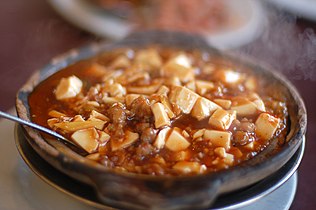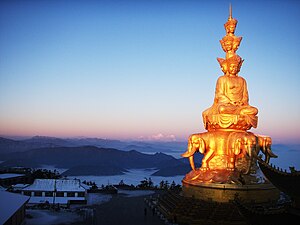Sichuan
Sichuan
Tứ xuyên | |
|---|---|
| Province of Sichuan | |
| Name transcription(s) | |
| •Chinese | Tứ xuyên tỉnh(Sìchuān Shěng) |
| •Abbreviation | SC /Xuyên(pinyin:Chuān) |
(clockwise from top)
| |
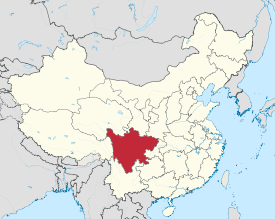 Map showing the location of Sichuan Province | |
| Coordinates:30°30′N102°30′E/ 30.5°N 102.5°E | |
| Country | China |
| Capital (and largest city) | Chengdu |
| Divisions | 21prefectures,181, 5011 |
| Government | |
| • Type | Province |
| • Body | Sichuan Provincial People's Congress |
| •CCP Secretary | Wang Xiaohui |
| •Congresschairman | Wang Xiaohui |
| •Governor | Huang Qiang |
| •CPPCCchairwoman | Tian Xiangli |
| •National People's CongressRepresentation | 147 deputies |
| Area | |
| • Total | 485,000 km2(187,000 sq mi) |
| • Rank | 5th |
| Highest elevation | 7,556 m (24,790 ft) |
| Population (2020)[2] | |
| • Total | 83,674,866 |
| • Rank | 5th |
| • Density | 170/km2(450/sq mi) |
| • Rank | 22nd |
| Demographics | |
| • Ethnic composition | Han– 95% Yi– 2.6% Tibetan– 1.5% Qiang– 0.4% Others – 0.5% |
| • Languages and dialects | Southwestern Mandarin(Sichuanese),Khams Tibetan,Hakka Chinese |
| GDP(2023)[3] | |
| • Total | CN¥6,013 billion (5th)
US$853 billion |
| • Per capita | CN¥ 71,835 (20th)
US$ 10,194 |
| ISO 3166 code | CN-SC |
| HDI(2021) | 0.740[4](high) (23rd) |
| Website | SC.gov.cn |
| Sichuan | |||||||||||||||||||||||||||||||||||||||||||
|---|---|---|---|---|---|---|---|---|---|---|---|---|---|---|---|---|---|---|---|---|---|---|---|---|---|---|---|---|---|---|---|---|---|---|---|---|---|---|---|---|---|---|---|
"Sichuan" in Chinese characters | |||||||||||||||||||||||||||||||||||||||||||
| Chinese name | |||||||||||||||||||||||||||||||||||||||||||
| Chinese | Tứ xuyên | ||||||||||||||||||||||||||||||||||||||||||
| Postal | Szechwan | ||||||||||||||||||||||||||||||||||||||||||
| Literal meaning | "Four Plains"[5] | ||||||||||||||||||||||||||||||||||||||||||
| |||||||||||||||||||||||||||||||||||||||||||
| Tibetan name | |||||||||||||||||||||||||||||||||||||||||||
| Tibetan | སི་ཁྲོན་ | ||||||||||||||||||||||||||||||||||||||||||
| |||||||||||||||||||||||||||||||||||||||||||
| Yiname | |||||||||||||||||||||||||||||||||||||||||||
| Yi | ꌧꍧ syp chuo | ||||||||||||||||||||||||||||||||||||||||||
| Former names | |||||||||||||
|---|---|---|---|---|---|---|---|---|---|---|---|---|---|
| Ba (today's Chongqing municipalities) and Shu (today's Sichuan province) | |||||||||||||
| Chinese | Ba thục | ||||||||||||
| |||||||||||||
Sichuan[a]is aprovinceinSouthwestern Chinaoccupying theSichuan BasinandTibetan Plateaubetween theJinsha Riveron the west, theDaba Mountainsin the north and theYungui Plateauto the south. Sichuan's capital city isChengdu;its population stands at 83 million. Sichuan neighborsQinghaito the northwest,Gansuto the north,Shaanxito the northeast,Chongqing(historically part of Sichuan) to the east,Guizhouto the southeast,Yunnanto the south, andTibetto the west.
In antiquity, Sichuan was home to the kingdoms ofancient stateofBaandShuuntil their incorporation by theQin.During theThree Kingdomsera,Liu Bei's state ofShuwas based in Sichuan. The area was devastated in the 17th century byZhang Xianzhong's rebellion and the area's subsequentManchuconquest, but recovered to become one of China's most productive areas by the 19th century. DuringWorld War II,Chongqingserved as the temporary capital of theRepublic of China,and was thusheavily bombed.It was one of the lastmainlandareas captured by thePeople's Liberation Armyduring theChinese Civil War,and was divided into four parts from 1949 to 1952, with Chongqing restored two years later. It suffered gravely during theGreat Chinese Famineof 1959–61 but remained China'smost populous provinceuntilChongqing Municipalitywas again separated from it in 1997.
TheHan Chinesepeopleof Sichuan speak distinctiveSichuanese dialectsofMandarin Chinese.The spicySichuan pepperis prominent in modernSichuan cuisine,featuring dishes—includingKung Pao chickenandmapo tofu—that have become staples of Chinese cuisine around the world.
Sichuan is the6th-largest provincial economyof China, the largest inWestern Chinaand the second largest among inland provinces afterHenan.As of 2021, its nominal GDP was 5,385 billion yuan (US$847.68 billion), ahead of the GDP of Turkey of 815 billion.[7][8]Compared to a country, it would be the18th-largest economyas well as the19th most populousas of 2021.[9]
There are manypandastations in the province and large reserves for these creatures, such as theChengdu Research Base of Giant Panda Breeding.
Names[edit]
It is commonly believed that the nameSichuanmeans "fourrivers";infolk etymology,this is usually taken to mean four of the province's major rivers: theJialing,Jinsha(orWu),Min,andTuo.[10][11]According tohistorical geographerTan Qixiang,"four rivers" is an erroneous interpretation of the place's name.[12]The name of the province is a contraction of the phrasesSì Chuānlù(TứXuyênLộ,"Four PlainCircuits") andChuānxiá Sìlù(Xuyên hiệp tứ lộ,"Four Circuits of Chuanxia" ),[note 1][13]referring to the division of the existingimperialadministrative circuit in the area into four during theNorthern Song dynasty,which wereYizhou,Lizhou,Zizhou,andKuizhou.[14]The wordchuan(Xuyên) here means "plain",not its normal meaning of" river "as popularly assumed.[15][16]In addition to itspostal mapandWade-Gilesforms, the name has also been irregularly romanized asSzű-chuanandSzechuen.
In antiquity, the area of modern Sichuan including the now separated Chongqing Municipality was known to theChineseasBa-Shu,in reference to theancient stateofBaand theancient kingdom of Shuthat once occupied theSichuan Basin.Shucontinued to be used to refer to the Sichuan region all through its history right up to the present day; several states formed in the area used the same name, for example, theShuof theThree Kingdomsperiod, andFormer ShuandLater Shuof theTen Kingdomsperiod.[17]Currently, both the characters forShuandChuanare commonly used as abbreviations for Sichuan.[18]
The region was formerly also referred to as "West China"or"Western China"byProtestant missions.
History[edit]
Prehistory[edit]
TheSichuan Basinand adjacent areas of theYangtzewatershed were a cradle of indigenous civilizations dating back to at least the 15th century BC, coinciding with theShangin northern China. The region had its own distinct religious beliefs and worldview. The earliest excavated culture found therein is theBaodun culture(c.2700–1750 BC) excavated in theChengdu Plain.[19][20]
Ba and Shu Kingdoms[edit]


The most important native states were those of Ba and Shu.
Bastretched into Sichuan from theHan ValleyinShaanxiandHubeidown theJialing Riveras far as its confluence with theYangtzeatChongqing.[21]
Shuoccupied the valley of theMin,includingChengduand other areas of western Sichuan.[21]The existence of the early state of Shu was poorly recorded in the main historical records of China. It was, however, referred to in theBook of Documentsas an ally of the Zhou.[22]Accounts of Shu exist mainly as a mixture of mythological stories and historical legends recorded in local annals such as theChronicles of Huayangcompiled in theJin dynasty (266–420),[23][24]and the Han-dynasty compilationChronicle of the Kings of Shu.[25]These contained folk stories such as that ofEmperor Duyuwho taught the people agriculture and transformed himself into a cuckoo after his death.[26]The existence of a highly developed civilization with an independent bronze industry in Sichuan was excavated in 1986 at a small village namedSanxingduiinGuanghan,Sichuan.[26]This site, believed to be an ancient city of Shu, was initially discovered by a local farmer in 1929 who found jade and stone artifacts. Excavations by archeologists yielded few significant finds until 1986 when two major sacrificial pits were found with spectacular bronze items as well as artifacts in jade, gold, earthenware, and stone.[27]This and other discoveries in Sichuan contest the conventional historiography that the local culture and technology of Sichuan were undeveloped in comparison to the technologically and culturally "advanced"Yellow Rivervalley of north-central China.[citation needed]
Qin dynasty[edit]
The rulers of the expansionist state ofQin,based in present-dayGansuandShaanxi,were the first strategists to realize that the area's military importance matched its commercial and agricultural significance. The Sichuan basin is surrounded by theHengduan Mountainsto the west, theQin Mountainsto the north, andYungui Plateauto the south. Since the Yangtze flows through the basin and then through the perilous Three Gorges to eastern and southern China, Sichuan was a staging area for amphibious military forces and a haven for political refugees.[citation needed]
Qin armies finished their conquest of the kingdoms of Shu and Ba by 316 BC. Any written records and civil achievements of earlier kingdoms were destroyed. Qin administrators introduced improved agricultural technology.Li Bing,engineered theDujiangyan irrigation systemto control theMin River,a majortributaryof the Yangtze. This innovative hydraulic system was composed of movable weirs which could be adjusted for high or low water flow according to the season, to either provide irrigation or prevent floods. The increased agricultural output and taxes made the area a source of provisions and men for Qin's unification of China.[citation needed]
Han dynasty[edit]

Sichuan was subjected to the autonomous control of kings named by the imperial family of the Han dynasty. During the 11 years hiatus between 25 and 36 AD, Sichuan was controlled by theChengjiaKingdom. Following the declining central government of theHan dynastyin the second century, the Sichuan basin, surrounded by mountains and easily defensible, became a popular place for upstart generals to found kingdoms that challenged the authority of Yangtze Valley emperors over China.[28]

Three Kingdoms[edit]
In 221, during the partition following the fall of theEastern Han– the era of theThree Kingdoms–Liu Beifounded the southwest kingdom ofShu Han(ThụcHán;221–263) in parts of Sichuan, Guizhou, and Yunnan, withChengduas its capital. Shu-Han claimed to be the successor to the Han dynasty.[28]
In 263, theCao Weiof North Chinaconqueredthe Kingdom of Shu-Han as a step on the path to reuniting China.Salt productionbecomes a major business inZiliujing District.During theSix Dynastiesperiod of Chinese disunity, Sichuan began to be populated by non-Hanethnic minority peoples, owing to the migration ofGelao peoplefrom theYunnan–Guizhou Plateauto the Sichuan basin.[citation needed]
Tang dynasty[edit]

Sichuan came under the firm control of a Chinese central government during theSui dynasty,but it was during the subsequentTang dynastythat Sichuan regained its previous political and cultural prominence for which it was known during the Han. Chengdu became nationally known as a supplier of armies and the home ofDu Fu,who is sometimes called China's greatest poet. During theAn Lushan Rebellion(755–763),Emperor Xuanzong of Tangfled fromChang'anto Sichuan which became his refuge. The region was torn by constant warfare and economic distress as it was besieged by theTibetan Empire.[29]
Five Dynasties and Ten Kingdoms[edit]
In theFive Dynasties and Ten Kingdoms period,Sichuan became the heart of theShu kingdomwith its capital inChengdu.In 925, the kingdom was absorbed intoLater Tangbut would regain independence underMeng Zhixiangwho foundedLater Shuin 934. Later Shu would continue until 965 when it was absorbed by theSong.
Song and Yuan dynasties[edit]
During theSong dynasty(960–1279),Sichuanesewas able to protect themselves fromTibetanattacks with the help of the central government. There were rebellions against the Song by Li Shun in 994 and Wang Jun in 1000. Sichuan also saw cultural revivals like the great poetsSu Xun(Tô tuân),Su Shi,andSu Zhe.[29]Although paper currency was known in the Tang dynasty, in 1023 AD, the first truepaper moneyin human history (Giao tử;jiāozǐ) was issued inChengdu.[30][31][32]
It was also during the Song dynasty that the bulk of the nativeBa peopleof eastern Sichuan assimilated into the Han Chinese ethnicity.[33]
In the 12th and 13th centuries, the Southern Song dynasty established coordinated defenses against theMongolianYuan dynasty,in Sichuan andXiangyang.The Southern Song state monopolized the Sichuan tea industry to pay for warhorses, but this state intervention eventually brought devastation to the local economy.[34]The line of defense was finally broken through after the first use offirearmsin history during the six-yearBattle of Xiangyang,which ended in 1273. Allegedly there were a million pieces of unspecified types of skeleton bones belonging to war animals and both Song and Yuan soldiers who perished in the fighting over the city, although the figure may have been grossly exaggerated.[35]The recorded number of families in Sichuan dropped from 2,640,000 families,[36]as recorded from the census taken in 1162 AD, to 120,000 families[37]in 1282 AD.[38]Possible causes include forced population transfer to nearby areas, evacuation to nearby provinces, census under-reporting or inaccuracy, and war-related deaths.[citation needed] One instance of the deportation of Sichuanese civilians to Mongolia occurred in the aftermath of a battle in 1259 when more than 80,000 people were taken captive from one city in Sichuan and moved to Mongolia.[39]
Ming dynasty[edit]

The Ming dynasty defeatedMing Yuzhen's Xia polity which ruled Sichuan.[40]
During theMing dynasty,major architectural works were created in Sichuan. Buddhism remained influential in the region.Bao'en Templeis a well-preserved 15th-century monastery complex built between 1440 and 1446 during theZhengtong Emperor's reign (1427–64). Dabei Hall enshrines a thousand-armed wooden image ofGuanyinand Huayan Hall is a repository with a revolvingsutracabinet. The wall paintings, sculptures, and other ornamental details are masterpieces of the Ming period.[41]
In the middle of the 17th century, the peasant rebel leaderZhang Xianzhong(1606–1646) fromYan'an,ShaanxiProvince, nicknamedYellow Tiger,led his peasant troop from north China to the south and conquered Sichuan. Upon capturing it, he declared himself emperor of the Daxi dynasty (Đại tây vương triều). In response to the resistance from local elites, he massacred a large number of people in Sichuan, killing around one in three people.[42][43]As a result of the massacre as well as years of turmoil during theMing-Qing transition,the population of Sichuan fell sharply, requiring massive resettlement of people from the neighboringHuguang Province(modern Hubei and Hunan) and other provinces during the Qing dynasty.[44][45][46]
Qing dynasty[edit]
Sichuan was originally the origin of the Deng lineage until one of them was hired as an official in Guangdong during the Ming dynasty but during the Qing plan to increase the population in 1671 they came to Sichuan again. In 1904Deng Xiaopingwas born in Sichuan.[47]
During theQing dynasty,Sichuan was merged withShaanxiandShanxito create "Shenzhuan" during 1680–1731 and 1735–1748.[29]The current borders of Sichuan (which then includedChongqing) were established in the early 18th century. In the aftermath of theSino-Nepalese Waron China's southwestern border, the Qing gave Sichuan's provincial government direct control over the minority-inhabited areas of Sichuan west ofKangding,which had previously been handled by anamban.[45]
Alandslide damon theDadu Rivercaused by an earthquake gave way on 10 June 1786. The resulting flood killed 100,000 people.[48]
Republic of China[edit]

In the early 20th century, the newly foundedRepublic of Chinaestablished the Chuanbian Special Administrative District (Xuyên biên đặc biệt hành chính khu) on the province's territories to the west of theSichuan Basin.The Special District later became the province ofXikang,incorporating the areas inhabited byYi,Tibetan,andQiangethnic minorities to its west, and eastern part of today'sTibet Autonomous Region.[citation needed]
In the 20th century, asBeijing,Shanghai,Nanjing,andWuhanhad all been occupied by the Japanese during theSecond Sino-Japanese War,the capital of the Republic of China had been temporarily relocated toChongqing,then a major city in Sichuan. An enduring legacy of this move is those nearby inland provinces, such asShaanxi,Gansu,andGuizhou,which previously never hadmodern Western-style universities,began to be developed in this regard.[49]The difficulty of accessing the region overland from the eastern part of China and the foggy climate hindering the accuracy of theJapanese bombingof the Sichuan Basin made the region the stronghold ofChiang Kai-shek'sKuomintanggovernment during 1938–45 and led to theBombing of Chongqing.[citation needed]
TheSecond Sino-Japanese Warwas soon followed by the resumedChinese Civil War,and the cities of East China are obtained by the Communists one after another, the Kuomintang government again tried to make Sichuan its stronghold on the mainland, although it already saw some Communist activity since it was one area on the road of theLong March.Chiang Kai-shek himself flew to Chongqing fromTaiwanin November 1949 to lead the defense. But the same month Chongqing switched to the Communists, followed by Chengdu on 10 December. The Kuomintang generalWang Shengwanted to stay behind with his troops to continue the anticommunist guerilla war in Sichuan, but was recalled to Taiwan. Many of his soldiers made their way there as well, viaBurma.[50]
People's Republic of China[edit]
The People's Republic of China was founded in 1949, and it split Sichuan into four areas and separated Chongqing municipality. Sichuan was reconstituted in 1952, with Chongqing added in 1954, while the formerXikangprovince was split betweenTibetin the west and Sichuan in the east.[29]
The province was deeply affected by theGreat Chinese Famineof 1959–1961, during which period some 9.4 million people (13.07% of the population at the time) died.[51]
In 1978, whenDeng Xiaopingtook power, Sichuan was one of the first provinces to experiment with the market economic enterprise.
From 1955 until 1997 Sichuan had been China's most populous province, hitting the 100 million mark shortly after the 1982 census figure of 99,730,000.[52]This changed in 1997 when theSub-provincial cityof Chongqing as well as the three surrounding prefectures ofFuling,Wanxian,andQianjiangwere split off into the newChongqing Municipality.The new municipality was formed to spearhead China's effort to economically develop its western provinces, as well as to coordinate the resettlement of residents from the reservoir areas of theThree Gorges Damproject.
In 1997 when Sichuan split, the sum of the two parts was recorded to be 114,720,000 people.[53]As of 2010, Sichuan ranks as both the3rd largest(the largest among Chineseprovinces with a population greater than 50 million) and 4th most populous provincein China.[54]
In May 2008,an earthquakewith a magnitude of 7.9/8.0 hit just 79 km (49 mi) northwest of the provincial capital of Chengdu. Official figures recorded a death toll of nearly 70,000 people, and millions of people were left homeless.[55]
Administrative divisions[edit]
Sichuan consists of twenty-oneprefecture-level divisions:eighteenprefecture-level cities(including asub-provincial city) and threeautonomous prefectures:
| Administrative divisions of Sichuan | |||||||||||
|---|---|---|---|---|---|---|---|---|---|---|---|
| Division code[56] | Division | Area in km2[57] | Population 2020[58] | Seat | Divisions[59] | ||||||
| Districts | Counties | Aut. counties | CL cities | ||||||||
| 510000 | Sichuan Province | 485,000.00 | 83,674,866 | Chengducity | 55 | 105 | 4 | 19 | |||
| 510100 | Chengducity | 12,163.16 | 20,937,757 | Wuhou District | 12 | 3 | 5 | ||||
| 510300 | Zigongcity | 4,373.13 | 2,489,256 | Ziliujing District | 4 | 2 | |||||
| 510400 | Panzhihuacity | 7,423.42 | 1,212,203 | Dong District | 3 | 2 | |||||
| 510500 | Luzhoucity | 12,233.58 | 4,254,149 | Jiangyang District | 3 | 4 | |||||
| 510600 | Deyangcity | 5,951.55 | 3,456,161 | Jingyang District | 2 | 1 | 3 | ||||
| 510700 | Mianyangcity | 20,267.46 | 4,868,243 | Fucheng District | 3 | 4 | 1 | 1 | |||
| 510800 | Guangyuancity | 16,313.70 | 2,305,657 | Lizhou District | 3 | 4 | |||||
| 510900 | Suiningcity | 5,323.85 | 2,814,196 | Chuanshan District | 2 | 2 | 1 | ||||
| 511000 | Neijiangcity | 5,385.33 | 3,140,678 | Shizhong District | 2 | 2 | 1 | ||||
| 511100 | Leshancity | 12,827.49 | 3,160,168 | Shizhong District | 4 | 4 | 2 | 1 | |||
| 511300 | Nanchongcity | 12,479.96 | 5,607,565 | Shunqing District | 3 | 5 | 1 | ||||
| 511400 | Meishancity | 7,173.82 | 2,955,219 | Dongpo District | 2 | 4 | |||||
| 511500 | Yibincity | 13,293.89 | 4 588 804 | Cuiping District | 3 | 7 | |||||
| 511600 | Guang'ancity | 6,301.41 | 3,254,883 | Guang'an District | 2 | 3 | 1 | ||||
| 511700 | Dazhoucity | 16,591.00 | 5,385,422 | Tongchuan District | 2 | 4 | 1 | ||||
| 511800 | Ya'ancity | 15,213.28 | 1,434,603 | Yucheng District | 2 | 6 | |||||
| 511900 | Bazhongcity | 12,301.26 | 2,712,894 | Bazhou District | 2 | 3 | |||||
| 512000 | Ziyangcity | 7,962.56 | 2,308,631 | Yanjiang District | 1 | 2 | |||||
| 513200 | Ngawa Tibetan and Qiang Autonomous Prefecture | 82,383.32 | 822,587 | Barkamcity | 12 | 1 | |||||
| 513300 | Garzê Tibetan Autonomous Prefecture | 147,681.37 | 1,107,431 | Kangdingcity | 17 | 1 | |||||
| 513400 | Liangshan Yi Autonomous Prefecture | 60,422.67 | 4,858,359 | Xichangcity | 14 | 1 | 2 | ||||
| Administrative divisions in Chinese and varieties of romanizations | ||||
|---|---|---|---|---|
| English | Chinese | Pinyin | Sichuanese Romanzation | |
| Sichuan Province | Tứ xuyên tỉnh | Sìchuān Shěng | si4 cuan1 sen3 | |
| Chengducity | Thành đô thị | Chéngdū Shì | cen2 du1 si4 | |
| Zigongcity | Tự cống thị | Zìgòng Shì | ||
| Panzhihuacity | Phàn chi hoa thị | Pānzhīhuā Shì | ||
| Luzhoucity | Lô châu thị | Lúzhōu Shì | nu2 zou1 si4 | |
| Deyangcity | Đức dương thị | Déyáng Shì | ||
| Mianyangcity | Miên dương thị | Miányáng Shì | ||
| Guangyuancity | Quảng nguyên thị | Guǎngyuán Shì | ||
| Suiningcity | Toại ninh thị | Sùiníng Shì | xu4 nin2 si4 | |
| Neijiangcity | Nội giang thị | Nèijiāng Shì | nui4 jiang1 si4 | |
| Leshancity | Nhạc sơn thị | Lèshān Shì | ||
| Nanchongcity | Nam sung thị | Nánchōng Shì | lan2 cong1 si4 | |
| Meishancity | Mi sơn thị | Méishān Shì | mi2 san1 si4 | |
| Yibincity | Nghi tân thị | Yíbīn Shì | ni2 bin1 si4 | |
| Guang'ancity | Quảng an thị | Guǎng'ān Shì | ||
| Dazhoucity | Đạt châu thị | Dázhōu Shì | ||
| Ya'ancity | Nhã an thị | Yǎ'ān Shì | ||
| Bazhongcity | Ba trung thị | Bāzhōng Shì | ||
| Ziyangcity | Tư dương thị | Zīyáng Shì | ||
| Ngawa Tibetan and Qiang Autonomous Prefecture | A bá tàng tộc khương tộc tự trị châu | Ābà Zangzú Qiāngzú Zìzhìzhōu | ||
| Garzê Tibetan Autonomous Prefecture | Cam tư tàng tộc tự trị châu | Gānzī Zangzú Zìzhìzhōu | ||
| Liangshan Yi Autonomous Prefecture | Lương sơn di tộc tự trị châu | Liángshān Yízú Zìzhìzhōu | ||
The twentyprefecturesof Sichuan are subdivided into 183county-level divisions(53districts,17county-level cities,109counties,and 4autonomous counties). At the end of the year 2017, the total population is 83.02 million.[60]
Urban areas[edit]
| Population by urban areas of prefecture & county cities | ||||
|---|---|---|---|---|
| # | Cities | 2020 Urban area[61] | 2010 Urban area[62] | 2020 City proper |
| 1 | Chengdu[b] | 13,568,357 | 6,316,922[c] | 20,937,757 |
| 2 | Mianyang | 1,549,499 | 967,007[d] | 4,868,243 |
| 3 | Yibin | 1,290,555 | 549,650[e] | 4,588,804 |
| 4 | Nanchong | 1,254,455 | 890,402 | 5,607,565 |
| 5 | Luzhou | 1,128,479 | 742,274 | 4,254,149 |
| 6 | Dazhou | 1,112,996 | 379,467[f] | 5,385,422 |
| 7 | Zigong | 868,565 | 666,204 | 2,489,256 |
| 8 | Suining | 829,356 | 549,826 | 2,814,196 |
| 9 | Leshan | 819,038 | 678,752 | 3,160,168 |
| 10 | Meishan | 732,757 | 347,546[g] | 2,955,219 |
| 11 | Deyang | 716,820 | 530,122[h] | 3,456,161 |
| 12 | Panzhihua | 686,063 | 631,258 | 1,212,203 |
| 13 | Xichang | 636,367 | 466,732 | part ofLiangshan Prefecture |
| 14 | Neijiang | 615,845 | 586,445 | 3,140,678 |
| 15 | Jianyang | 591,224 | 365,386 | see Chengdu[b] |
| 16 | Guangyuan | 556,842 | 407,756 | 2,305,657 |
| 17 | Bazhong | 549,128 | 477,235 | 2,712,894 |
| 18 | Guang'an | 485,180 | 317,502 | 3,254,883 |
| 19 | Ziyang[b] | 462,287 | 376,387 | 2,308,631 |
| 20 | Shehong | 442,852 | [i] | see Suining |
| 21 | Dujiangyan | 436,619 | 317,627 | see Chengdu |
| 22 | Chongzhou | 391,259 | 206,448 | see Chengdu |
| 23 | Jiangyou | 387,892 | 312,154 | see Mianyang |
| 24 | Pengzhou | 383,409 | 263,199 | see Chengdu |
| 25 | Guanghan | 368,933 | 235,872 | see Deyang |
| 26 | Ya'an | 343,062 | 208,940[j] | 1,434,603 |
| 27 | Qionglai | 322,777 | 190,099 | see Chengdu |
| 28 | Langzhong | 303,044 | 242,535 | see Nanchong |
| 29 | Longchang | 275,419 | [k] | see Neijiang |
| 30 | Emeishan | 252,682 | 220,349 | see Leshan |
| 31 | Mianzhu | 232,761 | 192,001 | see Deyang |
| 32 | Shifang | 223,320 | 187,473 | see Deyang |
| 33 | Wanyuan | 172,148 | 129,617 | see Dazhou |
| 34 | Huaying | 145,959 | 119,228 | see Guang'an |
| 35 | Kangding | 69,728 | [l] | part ofGarzê Prefecture |
| 36 | Barkam | 31,405 | [m] | part ofNgawa Prefecture |
- ^/sɪtʃˈwɑːn/[6]Chinese:,Mandarin:[sɹ̩̂.ʈʂʰwán];pinyin:Sìchuān;Sichuanese romanization:Sïchuan;commonly knownasSzechwanorSzechuan
- ^abcJianyang CLC was transferred from Ziyang PLC to Chengdu PLC's jurisdiction after 2010 census.
- ^New districts established after 2010 census:Shuangliu (Shuangliu County),Pidu (Pixian County),Xinjin (Xinjin County).These new districts not included in the urban area count of the pre-expanded city.
- ^New district established after 2010 census:Anzhou (Anxian County).The new district not included in the urban area count of the pre-expanded city.
- ^New districts established after 2010 census:Nanxi (Nanxi County),Xuzhou (Yibin County).These new districts not included in the urban area count of the pre-expanded city.
- ^New district established after 2010 census:Dachuan (Daxian County).The new district not included in the urban area count of the pre-expanded city.
- ^New district established after 2010 census:Pengshan (Pengshan County).The new district not included in the urban area count of the pre-expanded city.
- ^New district established after 2010 census:Luojiang (Luojiang County).The new district not included in the urban area count of the pre-expanded city.
- ^Shehong County is currently known as Shehong CLC after 2010 census.
- ^New district established after 2010 census:Mingshan (Mingshan County).The new district not included in the urban area count of the pre-expanded city.
- ^Longchang County is currently known as Longchang CLC after 2010 census.
- ^Kangding County is currently known as Kangding CLC after 2010 census.
- ^Barkam County is currently known as Barkam CLC after 2010 census.
Geography and biodiversity[edit]
Sichuan consists of two geographically very distinct parts. The eastern part of the province is mostly within the fertileSichuan basin(which is shared by Sichuan with Chongqing Municipality). The western Sichuan consists of numerous mountain ranges forming the easternmost part of theTibetan Plateau,which are known generically as theHengduan Mountains.One of these ranges, theDaxue Mountains,contains the highest point of the provinceGongga Shan,at 7,556 m (24,790 ft) above sea level. The mountains are formed by the collision of the Tibetan Plateau with theYangtze Plate.Faults here include theLongmenshan Faultwhich ruptured during the 2008 Sichuan earthquake. Other mountain ranges surround the Sichuan Basin from north, east, and south. Among them are theDaba Mountains,in the province's northeast.
TheYangtze Riverand its tributaries flow through the mountains of western Sichuan and the Sichuan Basin; thus, the province is upstream of the great cities that stand along the Yangtze River further to the east, such asChongqing,Wuhan,Nanjing,andShanghai.One of the major tributaries of the Yangtze within the province is theMin Riverof central Sichuan, which joins the Yangtze atYibin.There are also a number of other rivers, such as theJialing River,Tuo River,Yalong River,Wu River,andJinsha River,and any four of the various rivers are often grouped as the "four rivers" that the name of Sichuan is commonly and mistakenly believed to mean.[10][11]

Due to great differences in terrain, the climate of the province is highly variable. In general, it has strongmonsoonalinfluences, with rainfall heavily concentrated in the summer. Under theKöppen climate classification,theSichuan Basin(includingChengdu) in the eastern half of the province experiences ahumid subtropical climate(KöppenCwaorCfa), with long, hot, wet summers and short, mild to cool, dry, and cloudy winters. Consequently, it has China's lowest sunshine totals. The western region has mountainous areas producing a cooler but sunnier climate. Having cool to very cold winters and mild summers, temperatures generally decrease with greater elevation. However, due to its high altitude and its inland location, many areas such as Garze County and Zoige County in Sichuan exhibit asubarctic climate(KöppenDwc)- featuring extremely cold winters down to −30 °C and even cold summer nights. The region is geologically active with landslides and earthquakes. Average elevation ranges from 2,000 to 3,500 meters; average temperatures range from 0 to 15 °C.[63]The southern part of the province, including Panzhihua and Xichang, has a sunny climate with short, very mild winters and very warm to hot summers.
Sichuan bordersQinghaito the northwest,Gansuto the north,Shaanxito the northeast,Chongqingto the east,Guizhouto the southeast,Yunnanto the south, and theTibet Autonomous Regionto the west.
-
Larix potaniniiin fall.
-
Linpan in Chengdu Plainis a well-known landmark inChengdu Plain,Sichuan.
Giant panda[edit]
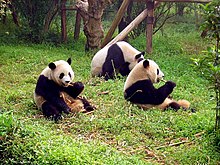
Giant pandaslive inbamboo forestsand low mountainous areas such as theMinshan Mountainsin Sichuan.[64]The majority of the panda population lives in Sichuan, with their range spreading intoShaanxiandGansu.As it is abundant where they live, pandas' diet consists of 99% bamboo, with small other plants, or small animals consisting of the other 1%. As the panda is native to China, they have become a national symbol of China.[65]
Politics[edit]
The politics of Sichuan is structured in a dual party-government system like all other governing institutions inmainland China.
The governor of Sichuan is the highest-ranking official in the People's Government of Sichuan. However, in the province's dual party-government governing system, the Governor has less power than the Sichuan Communist Party of China'sParty Committee Secretary,colloquially termed the "Sichuan CCP Party Chief".
Economy[edit]

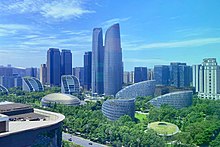
Sichuan is the6th-largest provincial economyof China, the largest inWestern Chinaand the second largest among inland provinces afterHenan.As of 2021, its nominal GDP was 5,385 billion yuan (US$847.68 billion), ahead of the GDP of Turkey of 815 billion.[7][8]Compared to a country, it would be the18th-largest economyas well as the19th most populousas of 2021.[9]As of 2021, its nominal GDP per capita was 64,357 RMB (US$10,120).[66]In 2021, the per capita net income of rural residents was 17,575 yuan (US$2760). The per capitadisposable incomeof the urbanites averaged 41,444 yuan (US$6510).
Sichuan has been historically known as the "Province of Abundance". It is one of the major agricultural production bases of China. Grain, including rice and wheat, is the major product with output that ranked first in China in 1999. Commercial crops include citrus fruits, sugar cane, sweet potatoes, peaches, and grapes. Sichuan also had the largest output of pork among all the provinces and the second largest output of silkworm cocoons in 1999. Sichuan is rich in mineral resources. It has more than 132 kinds of proven underground mineral resources including vanadium, titanium, and lithium is the largest in China. The Panxi region alone possesses 13.3% of the reserves of iron, 93% of titanium, 69% of vanadium, and 83% of cobalt in the whole country.[67]Sichuan also possesses China's largest proven natural gas reserves (such as theDazhou gas field), the majority of which are transported to more developed eastern regions.[54]
Sichuan is one of the major industrial centers of China. In addition to heavy industries such as coal, energy, iron, and steel, the province has also established a light industrial sector comprising building materials, wood processing, food, and silk processing.ChengduandMianyangare the production centers for textiles and electronics products.Deyang,Panzhihua,andYibinare the production centers for machinery, metallurgical industries, and wine, respectively. Sichuan's wine production accounted for 21.9% of the country's total production in 2000.
Great strides have been made in developing Sichuan into a modern hi-tech industrial base, by encouraging both domestic and foreign investments in electronics and information technology (such as software), machinery and metallurgy (including automobiles), hydropower, pharmaceutical, food and beverage industries.
The auto industry is an important and key sector of the machinery industry in Sichuan. Most of the auto manufacturing companies are located in Chengdu, Mianyang,Nanchong,andLuzhou.[68]
Other important industries in Sichuan includeaerospaceand defense (military) industries. A number of China's rockets (Long March rockets) andsatelliteswere launched from theXichang Satellite Launch Center,located in the city ofXichang.
Sichuan's landscapes and rich historical relics have also made the province a center for tourism.
TheThree Gorges Dam,the largestdamever constructed, was built on theYangtze Riverin nearbyHubeiprovince to control flooding in the Sichuan Basin, neighboringYunnanprovince, and downstream. The plan is hailed by some as China's efforts to shift towards alternative energy sources and to further develop its industrial and commercial bases, but has been denounced for mass resettlement, loss of archeological sites, and ecological damage.
Economic development zones[edit]
Chengdu Hi-tech Comprehensive Free Trade Zone[edit]
Chengdu Hi-tech Comprehensive Free Trade Zone was established with the approval of theState Councilon October 18, 2010, and passed the national acceptance on February 25, 2011. It was officially operated in May 2011. Chengdu High-tech Comprehensive Free Trade Zone is integrated and expanded from the former Chengdu Export Processing Zone and Chengdu Bonded Logistics Center. it is located in the Chengdu West High-tech Industrial Development Zone, with an area of 4.68 square kilometers and divided into three areas A, B, and C. The industries focus on notebook computer manufacturing, tablet computer manufacturing, wafer manufacturing, chip packaging testing, electronic components, precision machining, and the biopharmaceutical industry. Chengdu Hi-Tech Comprehensive Free Trade Zone has attracted the top 500 multinational enterprises such as Intel, Foxconn, Texas Instruments, Dell, Morse, and so on.
In 2020, the Chengdu Hi-Tech Comprehensive Free Trade Zone achieved a total import and export volume of 549.1 billion yuan (including the Shuangliu Sub-zone), accounting for 68% of the province's total foreign trade import and export volume, ranking first in the national comprehensive insurance zone import and export volume for three consecutive years.
Chengdu Economic and Technological Development Zone[edit]
Chengdu Economic and Technological Development Zone (Chinese:Thành đô kinh tế kỹ thuật khai phát khu;pinyin:Chéngdū jīngjì jìshù kāifā qū) was approved as state-level development zone in February 2000. The zone now has a developed area of 10.25 km2(3.96 sq mi) and a planned area of 26 km2(10 sq mi). Chengdu Economic and Technological Development Zone (CETDZ) lies 13.6 km (8.5 mi) east of Chengdu, the capital city of Sichuan Province and the hub of transportation and communication in southwest China. The zone has attracted investors and developers from more than 20 countries to carry out their projects there. Industries encouraged in the zone include mechanical, electronic, new building materials, medicine, and food processing.[69]
Chengdu Export Processing Zone[edit]
ChengduExport Processing Zone(Chinese:Thành đô xuất khẩu gia công khu;pinyin:Chéngdū chūkǒu jiāgōng qū)) was ratified by the State Council as one of the first 15 export processing zones in the country in April 2000. In 2002, the state ratified the establishment of the Sichuan Chengdu Export Processing West Zone with a planned area of 1.5 km2(0.58 sq mi), located inside the west region of the Chengdu Hi-tech Zone.[70]
Chengdu Hi-Tech Industrial Development Zone[edit]
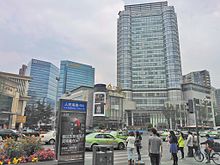
Established in 1988, Chengdu Hi-tech Industrial Development Zone (Chinese:Thành đô cao tân kỹ thuật sản nghiệp khai phát khu;pinyin:Chéngdū Gāoxīn Jìshù Chǎnyè Kāifā Qū) was approved as one of the first national hi-tech development zones in 1991. In 2000, it was open to APEC and has been recognized as a national advanced hi-tech development zone in successive assessment activities held by China's Ministry of Science and Technology. It ranks 5th among the 53 national hi-tech development zones in China in terms of comprehensive strength.
Chengdu Hi-tech Development Zone covers an area of 82.5 km2(31.9 sq mi), consisting of South Park and West Park. By relying on the city sub-center, which is under construction, South Park is focusing on creating a modernized industrial park of science and technology with scientific and technological innovation, incubation R&D, modern service industry, and Headquarters economy playing leading roles. Priority has been given to the development of the software industry. Located on both sides of the "Chengdu-Dujiangyan-Jiuzhaigou" golden tourism channel, the West Park aims at building a comprehensive industrial park targeting industrial clustering with complete supportive functions. West Park gives priority to three major industries i.e. electronic information, biomedicine, and precision machinery.[71]
Mianyang Hi-Tech Industrial Development Zone[edit]
Mianyang Hi-Tech Industrial Development Zone was established in 1992, with a planned area of 43 km2(17 sq mi). The zone is situated 96 kilometers away from Chengdu and is 8 km (5.0 mi) away from Mianyang Airport. Since its establishment, the zone accumulated 177.4 billion yuan of industrial output, 46.2 billion yuan of gross domestic product, and fiscal revenue of 6.768 billion yuan. There are more than 136 high-tech enterprises in the zone and they accounted for more than 90% of the total industrial output.
The zone is a leader in the electronic information industry, biological medicine, new materials, and the production of motor vehicles and parts.[72]
Transportation[edit]

For millennia, Sichuan's rugged and riverine landscape presented enormous challenges to the development of transportation infrastructure, and the lack of roads out of the Sichuan Basin contributed to the region's isolation. Since the 1950s, numerous highways and railways have been built through the Qinling in the north and the Bashan in the east. Dozens of bridgesacross the Yangtzeand its tributaries to the south and west have brought greater connectivity with Yunnan and Tibet.
Airports[edit]
Chengdu Shuangliu International Airportis the 4th-busiest airport in mainland China. It was among the world's top 30 busiest airports in 2015, and the busiest in western and central China. It was also the fifth-busiest airport in terms of cargo traffic in China in 2013. Chengdu airport is the hub ofSichuan Airlines,Chengdu Airlines,Shenzhen Airlines,Tibet Airlines,China Southern Airlines,China Eastern Airlines,Lucky Air,andAir China.Alongside Shuangliu Airport,Chengdu Tianfu International Airporthas opened in 2021.
Chengdu airports are also 144-hour transit visa-free airports for foreigners from 53 countries.
Expressways[edit]
On 3 November 2007, the Sichuan Transportation Bureau announced that theSuining-Chongqing Expresswaywas completed after three years of construction. After the completion of the Chongqing section of the road, the 36.64 km (22.77 mi) expressway connectedChengdu-Nanchong Expresswayand formed the shortest expressway fromChengdutoChongqing.The new expressway is 50 km (31 mi) shorter than the pre-existing road between Chengdu and Chongqing; thus journey time between the two cities was reduced by an hour, now taking two and a half hours. The Sui-Yu Expressway is a four-lane overpass with a speed limit of 80 km/h (50 mph). The total investment was 1.045 billionyuan.
Rail[edit]
China Railway Chengdu Groupis headquartered in Chengdu, the capital of Sichuan Province, managing railway systems in Sichuan, Chongqing, and Guizhou. Sichuan's major railways in Sichuan include theBaoji–Chengdu,Chengdu–Chongqing,Chengdu–Kunming,Neijiang–Kunming,Suining–Chongqing, and Chengdu–Dazhou railways.High-speed railwaysin Sichuan include theChengdu–Chongqing high-speed railway,Xi'an-Chengdu high-speed railway,Chengdu-Guiyang high-speed railway,and Chengdu–Kunming high-speed railway. A suburban railwayconnects Chengdu and Dujiangyan.
Demographics[edit]
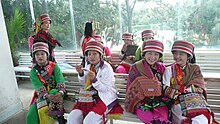
| Year | Pop. | ±% |
|---|---|---|
| 1912[73] | 48,130,000 | — |
| 1928[74] | 47,992,000 | −0.3% |
| 1936–37[75] | 52,706,000 | +9.8% |
| 1947[76] | 47,437,000 | −10.0% |
| 1954[77] | 62,303,999 | +31.3% |
| 1964[78] | 67,956,490 | +9.1% |
| 1982[79] | 99,713,310 | +46.7% |
| 1990[80] | 107,218,173 | +7.5% |
| 2000[81] | 82,348,296 | −23.2% |
| 2010[82] | 80,418,200 | −2.3% |
| 2020[83] | 83,674,866 | +4.0% |
| Chongqing was part of Sichuan Province until 1939 and 1954 to 1997. Xikang Provincedissolved in 1955 and parts were incorporated into Sichuan Province. | ||
The majority of the province's population isHan Chinese(95% of the provincial population), who are found scattered throughout the region except for the far western areas. Thus, significant minorities ofTibetan,Yakthung,Yi,Qiang,andNakhi peoplereside in the western portion that is impacted by inclement weather and natural disasters, environmentally fragile, and impoverished. Sichuan's capital ofChengduis home to a large community of Tibetans, with 30,000 permanent Tibetan residents and up to 200,000 Tibetanfloating population.[84]TheEastern Lipo,included with either the Yi or theLisu people,as well as theA-Hmao,also are among the ethnic groups of the provinces.
Sichuan was China'smost populous provincebeforeChongqingbecame a directly controlled municipality; it is currently the fourth most populous, after Guangdong, Shandong, and Henan. As of 1832, Sichuan was the most populous of the 18 provinces in China, with an estimated population at that time of 21 million.[85]It was the thirdmost populous sub-national entityin the world, afterUttar Pradesh,India,and theRussian Soviet Federative Socialist Republicuntil 1991, when theSoviet Unionwas dissolved. It is also one of the only eight subnational divisions to ever reach 100 million people (Uttar Pradesh, Russian RSFSR,Maharashtra,Sichuan,Bihar,Shandong,Guangdong,andPunjab). It is currently ranked 10th.
Religion[edit]
Religion in Sichuan[86][note 2]

The predominant religions in Sichuan areChinese folk religions,Taoist traditions,andChinese Buddhism.According to surveys conducted in 2007 and 2009, 10.6% of the population believes and is involved incults of ancestors,while 0.68% of the population identifies asChristian.[86]According to the Japanese publicationTokyo Sentakuin 1999, there were 2 million members ofYiguandao(Tiandao) in Sichuan, equal to 2.4% of the province's population.[88]
The reports did not give figures for other types of religion; the vast majority may be either irreligious or involved inChinese folk religion,Buddhism, etc.Tibetan Buddhismis widespread, especially in areas inhabited by ethnic Tibetans. Sichuan is one of the cradles of the earlyHeavenly Masters' Taoist religious movements.
According to "Vestiges of Zoroastrianism in Medieval Sichuan" (Đường tống thời kỳ ba thục địa khu đích hỏa hiên giáo di ngân) by Yao Chongxin, professor at Sun Yat-sen University,Zoroastrianismflourished during the period ofTang(618–907),Former Shu(907–925),Later Shu(934–965), andSong(960–1279).[91]
AChabad Jewish Centerwas established inChengduin 2012, after moving five times, a permanent location was secured atWuhou District.[92][93]
- Religious sites in Sichuan
-
View of the Temple of the Yellow Dragon (Chinese Buddhism) inHuanglong.
-
Statues of buddhas at Litang Monastery of the Tibetan tradition.
-
A pavilion of the Shangqing Temple (Taoist) in Qingchengshan,Chengdu.
-
Golden Temple ofMount Emei(Chinese Buddhism).
Culture[edit]
TheSichuanese people(Sichuanese:Ba thục nhânBa1su2ren2;IPA:[pa˥su˨˩zən˨˩];alternativelyXuyên nhân,Xuyên du nhân,Tứ xuyên nhânorBa thục dân hệ) are a subgroup of Han Chinese living in mostly Sichuan province and the neighboringChongqingmunicipality. Beginning from the 9th century BC,Shu(on theChengdu Plain) andBa(which had its first capital atEnshi CityinHubeiand controlled part of theHan Valley) emerged as cultural and administrative centers where two rival kingdoms were established. Although eventually, theQin dynastydestroyed the kingdoms of Shu and Ba, the Qin government accelerated the technological and agricultural advancements of Sichuan making it comparable to that of theYellow RiverValley. The now-extinctBa–Shu languagewas derived from Qin-era settlers and represents the earliest documented division from what is now calledMiddle Chinese.
During theYuanandMingdynasties, the population of the area was reduced through wars and thebubonic plague,and settlers arrived from the area of modern Hubei, replacing the earlier common Chinese with a new standard.
TheLi BaiMemorial, located inJiangyou,is a museum in memory of Li Bai, a Chinese poet ofTang China(618–907) built at the place where he grew up. The building was begun in 1962 on the occasion of the 1200th anniversary of his death, completed in 1981, and opened to the public in October 1982. The memorial is built in the style of the classic Tang garden.
In 2003, Sichuan had "88 art performing troupes, 185 culture centers, 133 libraries, and 52 museums". Companies based in Sichuan also produced 23 television series and one film.[94]
Languages[edit]

The Sichuanese once spoke their variety of Spoken Chinese called Ba-Shu Chinese, or Old Sichuanese before it became extinct during the Ming dynasty. Now most of them speak Sichuanese Mandarin. The Minjiang dialects are thought by some linguists[who?]to be a bona fide descendant of Old Sichuanese, but there is no conclusive evidence whether Minjiang dialects are derived from Old Sichuanese or Southwestern Mandarin.[citation needed]
The languages of Sichuan are primarily members of three subfamilies of theSino-Tibetan languages.
The most widely used variety of Chinese spoken in Sichuan isSichuanese,which is thelingua francain Sichuan,Chongqing,and parts of theTibet Autonomous Region.Although Sichuanese is generally classified as a dialect ofMandarin Chinese,it is highly divergent in phonology, vocabulary, and even grammar fromStandard Chinese.[95]TheMinjiang dialectis especially difficult for speakers of other Mandarin dialects to understand.[96][97][98][99]
Garzê Tibetan Autonomous PrefectureandNgawa Tibetan and Qiang Autonomous Prefecturein western Sichuan are populated byTibetansandQiang people.Tibetans speak theKhamsandAmdo Tibetan,which areTibetic languages,as well as variousQiangic languages.The Qiang speak Qiangic languages and often Tibetic languages as well. TheYi peopleofLiangshan Yi Autonomous Prefecturein southern Sichuan speak theNuosu language,which is one of theLolo-Burmese languages;Yi is written using theYi script,asyllabarystandardized in 1974. TheSouthwest University for Nationalitieshas one of China's most prominentTibetologydepartments and the Southwest Minorities Publishing House prints literature in minority languages.[100]In the minority-inhabited regions of Sichuan, there is bilingual signage and public school instruction in non-Mandarin minority languages.
Sichuan brocade[edit]

Commonly known as "Shu brocade" (Thục cẩm) in Chinese, Sichuan brocade is referred to as the "mother of brocade in China" given its age.[101]This technique of embroidery originates in the capital city ofChengduduring the time of theAncient Kingdom of Shu.It enjoyed high popularity throughout the regions along theSilk Road,which stimulated an "exoticization"of the embroidery designs during the 1st millennium, with most of the patterns imported fromSogdiaand other parts ofCentral Asia.[102]According to theBook of Sui,in the year 605 AD, the head of the Sichuan ateliers producing silks in the "western style" was a certain He Chou, a name which betrays his Sogdian origins.[103]Most of the silk products unearthed inXinjiang(Chinese Turkestan) andQinghai(Tuyuhun Kingdom) confirmed to be manufactured in Sichuan.[104]
Cuisine[edit]
Sichuan is well known for its spicy cuisine and use ofSichuan peppersdue to its humid climate. The Sichuanese are proud of their cuisine, known as one of the Four Great Traditions ofChinese cuisine.The cuisine here is of "one dish, one shape, hundreds of dishes, hundreds of tastes", as the saying goes, to describe its acclaimed diversity. The most prominent traits of Sichuanese cuisine are described by four words: spicy, hot, fresh, and fragrant.[105]Sichuan cuisine is popular in the whole nation of China, and so are Sichuan chefs.
Another famous Sichuan delicacy ishot pot.Hot pot is a Chinese soup containing a variety of East Asian foodstuffs and ingredients, prepared with a simmering pot of soup stock at the dining table. While the hot pot is kept simmering, ingredients are placed into the pot and cooked at the table. Typical hot pot dishes include thinly sliced meat, leaf vegetables, mushrooms, wontons, egg dumplings, tofu, and seafood. The cooked food is usually eaten with a dipping sauce.
-
Kung Pao chicken,one of the best known dishes of Sichuan cuisine
-
Zha Jiang Noodles(Tạp tương diện)
Education[edit]
Colleges and universities[edit]
As of 2022, Sichuan hosts 134 institutions of higher education, ranking first in theWestern Chinaregion and fifth among all Chinese provinces afterJiangsu,Guangdong,HenanandShandong.[106][107]
- Sichuan University(Chengdu)
- Southwest Jiaotong University(Chengdu)
- University of Electronic Science and Technology of China(Chengdu)
- Southwestern University of Finance and Economics(Chengdu)
- Chengdu University of Technology(Chengdu)
- Chengdu University of Information Technology(Chengdu)
- Chengdu University of Traditional Chinese Medicine(Chengdu)
- Civil Aviation Flight University of China(Guanghan)
- Southwest University for Nationalities(Chengdu)
- Sichuan Normal University(Chengdu)
- Sichuan Agricultural University(Ya'an,Chengdu,Dujiangyan)
- Southwest Petroleum University(Nanchongand Chengdu)
- Xihua University(Chengdu)
- Southwest University of Science and Technology(Mianyang)
- China West Normal University(Nanchong)
- North Sichuan Medical College(Nanchong)
- Panzhihua University (Panzhihua)
- Sichuan Police College (Luzhou)
- Sichuan University of Science and Engineering(ZigongandYibin)
- Chengdu University(Chengdu)
- Xichang University (Xichang)
- Aba Teachers University (Ngawa Tibetan and Qiang Autonomous Prefecture)
- Yibin University(Yibin)
Tourism[edit]
-
Waterfalls at Jiuzhaigou
-
BipenggouValley
-
Mount SiguniangScenic Area
-
HailuogouGlacier Forest Park
UNESCOWorld Heritage Sitesin Sichuan province and Chongqing municipality include:
- Dazu Rock CarvingsandWulong Karst(Chongqingmunicipality)
- Huanglong Scenic and Historic Interest Area
- Jiuzhaigou ValleyScenic and Historic Interest Area
- Mount EmeiScenic Area, includingLeshan Giant BuddhaScenic Area
- Mount Qinchengand theDujiangyan Irrigation System
- Sichuan Giant Panda Sanctuaries
As of July 2013, the world's largest building, theNew Century Global Centeris located in Chengdu. At 328 ft (100 m) high, 1,640 ft (500 m) long, and 1,312 ft (400 m) wide, the Center houses retail outlets, movie theaters, offices, hotels, the Paradise Island waterpark, an artificial beach, a 164 yd (150 m)-longLEDscreen, skating rink, pirate ship, fake Mediterranean village, 24-hour artificial sun, and 15,000-spot parking area.[108]
Visa exemption[edit]
144-hour Visa-free Transit[edit]
Holders of passports issued by 53 countries do not require a visa for a 144-hour stay if they are transiting throughChengdu Tianfu International AirportandChengdu Shuangliu International Airportof entry, provided that they:[109][110]
- hold passports valid for at least 3 months from the date of intended arrival and visas for the destination countries (if required); and
- hold ticket receipts (with confirmed seats, if applicable) departing in 144 hours, which shows that their first destination (including stopovers of any kind) outside China is located in a third country. Hong Kong and Macau are considered as third territories for transit purposes.
In order to qualify for the144-hour visa-free transit,the traveler's inbound and outbound flights must directly arrive at and depart from one of the acceptable ports of entry from or to a third territory (including one of the two SARs of Hong Kong and Macau). Both flights must have no stopovers of any kind within mainland China prior to arrival or after departure at the port of entry, and the outbound flight's first stop or destination must be in a different territory than the inbound flight's. Travels between U.S. territories and the contiguous U.S. are also ineligible for the 144-hour TWOV, unless one of their flights has a stopover in a third country or a SAR.[111]
Travelers utilizing the 144-hour visa-free transit scheme at Chengdu (both Chengdu Tianfu International Airport and Chengdu Shuangliu International Airport) are authorized to travel within the region of 11 cities in Sichuan Province during the period, includingChengdu City,Leshan City,Deyang City,Suining City,Meishan City,Ya'an City,Ziyang City,Neijiang City,Zigong City,Luzhou City,andYibin City.[112]
Eligible countries[113][edit]
|
|
- for British passport holders, only British citizens are eligible.
- Visa exemption in general
24-hour Visa-free Transit[edit]
Under the24-hour Visa-exemption policy,visa is not required for travelers who:
- hold a passport valid for at least 3 months from the date of entry;
- arrive by air, cruise ship or train (except for arriving at certain airports listed below);
- hold confirmed air, cruise ship or train tickets to a third-country final destination outside mainland China departing in 24 hours (standby tickets are not allowed); and,
- depart mainland China on a flight, cruise ship or train within 24 hours after arrival.
Most nationalities are eligible for the 24-hour Visa-exemption International Transit.
Notable individuals[edit]
- Ba Jin(25 November 1904 – 17 October 2005), novelist and writer
- Bai Ling,actress
- Bao Sanniang,a possibly fictional woman warrior of theThree Kingdomsperiod.
- Chang Chün,premier of the Republic of China
- Chang Dai-chien,artist
- Che Yongli(28 January 1980), actress
- Chen Kenmin(27 June 1912 – 12 May 1990), chef who specialized inSichuan cuisine.Father of well-knownIron Chef,Chen Kenichi.
- Chen Pokong(1963–), author, political commentator and democracy activist
- Chen Shou,official and writer
- Cheung Chung-kiu,business magnate
- Deng Xiaoping,Chinese Paramount Leader during the 1980s, hisformer residenceis now a museum.
- Guifeng Zongmi(780–841), Tang dynasty Buddhist scholar-monk, fifth patriarch of theHuayanschool as well as a patriarch of the Heze lineage of Southern Chan
- Guo Moruo,renowned author
- Akio Hong,broadcaster
- Huang Jiguang,highly decorated soldier during the Korean War
- Jiang Zhuyun,revolutionary martyr
- Li Bai(701–762), poet of the Tang dynasty
- Li Bifeng,activist
- Li Ching-Yuen,herbalist,martial artistand tactical advisor, also known for extremelongevity claims
- Li Shou-min, better known asHuanzhulouzhu(1902–1961), novelist of thexianxiagenre
- Li Shunxian(c. 900–926),Persian-Sichuanesepoet, concubine of EmperorWang ZongyanofFormer Shu
- Li Yifeng,actor and singer
- Li Yuchun,singer, songwriter, and actress
- Liao Yiwu,author, reporter, musician, and poet
- Liu Yonghao,businessman
- Luo Ruiqing,army officer and politician
- Meng Caicheng,( mông tài thành, 1859–1928), activist in theRailway Protection Movement
- Ouyang Xiu(1007–22 September 1072), Confucian historian, essayist, calligrapher, poet, and official bureaucrat of the Song dynasty
- Sanyu (painter)
- Song Cheng-tsi(1892–1955), Anglican bishop
- Song Yonghua,scholar
- Su Shi(8 January 1037 – 24 August 1101), Confucian bureaucrat official, poet, artist, calligrapher, pharmacologist, gastronome, and official bureaucrat of the Song dynasty
- Su Xun(1009–1066), poet and prose-writer of the Song dynasty
- Su Zhe(1039–1112), poet and essayist, a Confucian bureaucratic official of the Song dynasty
- Tan Weiwei,singer and actress
- Tang Chun-i,philosopher and scholar
- Wang Jiujiang(1957–), painter
- Wang Jianlin,business magnate, investor, and philanthropist
- Wang Xiaoya,television host and media personality
- Wang Yi (pastor)(1973–)
- Wuzhun Shifan(1178–1249), Zen Buddhist monk
- Xu Yiyang(12 August 1997), singer[114]
- Xu Youyu,scholar
- Yang Xiong,poet, philosopher, and politician
- Y. C. James Yen(1890/1893–1990), educator
- Lucy Yi Zhenmei(1815–1862), Roman Catholic saint
- Yu Jie(1973–), Calvinist democracy activist
- Zhang Aiping,from Tongchuan District, Dazhou City, Vice Premier, State Councilor, and Minister of Defense
- Jane Zhang,singer and songwriter
- Zhang Lan,political activist
- Zhang Yong (restaurateur),Singapore's richest man in 2019
- Zhao Yiman,resistance fighter
- Zheng Ji,nutritionist, and pioneering biochemist
- Zhu De,general, warlord, politician, and revolutionary
- Zhuo Wenjun,poet
- Zou Rong,revolutionary martyr
Sports[edit]
Professional sports teams in Sichuan include:
- Chinese Basketball Association
- Chinese Super League
- Chinese Volleyball League
- China Table Tennis Super League
Sister states and regions[edit]
 Washington,United States (1982)
Washington,United States (1982) Michigan,United States (1982)
Michigan,United States (1982) Hiroshima Prefecture,Japan (1984)
Hiroshima Prefecture,Japan (1984) Yamanashi Prefecture,Japan (1985)
Yamanashi Prefecture,Japan (1985) South P'yŏngan,North Korea (1985)
South P'yŏngan,North Korea (1985) Kedah,Malaysia (1985)
Kedah,Malaysia (1985) Midi-Pyrénées,France (1987)
Midi-Pyrénées,France (1987) North Rhine-Westphalia,Germany (1988)
North Rhine-Westphalia,Germany (1988) Leicestershire,United Kingdom (1988)
Leicestershire,United Kingdom (1988) Piedmont,Italy (1990)
Piedmont,Italy (1990) Pernambuco,Brazil (1992)
Pernambuco,Brazil (1992) Tolna County,Hungary (1993)
Tolna County,Hungary (1993) Valencian Community,Spain (1994)
Valencian Community,Spain (1994) Brussels-Capital Region,Belgium (1995)
Brussels-Capital Region,Belgium (1995) Barinas State,Venezuela (2001)
Barinas State,Venezuela (2001) Friesland,Netherlands (2001)
Friesland,Netherlands (2001) Almaty Province,Kazakhstan (2001)
Almaty Province,Kazakhstan (2001) Mpumalanga,South Africa (2002)
Mpumalanga,South Africa (2002) Suphan Buri,Thailand (2010)
Suphan Buri,Thailand (2010) Victoria,Australia (2015)
Victoria,Australia (2015) Lavalleja,Uruguay (2020)
Lavalleja,Uruguay (2020)
See also[edit]
Notes[edit]
- ^Si( tứ ) means "four",Chuan( xuyên ) means "plain", andXia( "Hiệp" ) could be understood as "gorge".Sì ChuānlùandChuānxiá Sìlùare general names for the Four Circuits,.
- ^Some of the data collected by the Chinese General Social Survey (CGSS) of 2009 and by the Chinese Spiritual Life Survey (CSLS) of 2007 have been reported and assembled by Xiuhua Wang (2015)[86]in order to confront the proportion of people identifying with two similar social structures: ① Christian churches, and ② the traditional Chinese religion of the lineage (i. e. people believing and worshiping ancestral deities oflineage "churches"andancestral shrines). Data for other religions with a significant presence in China (deity cults, Buddhism, Taoism, folk religious sects, Islam, et al.) were not reported by Wang and come from different sources.
- ^Based on a 2006 survey of the distribution of Buddhist institutions in China,[87]assuming that the percentage of institutions per capita is consistent with the percentage of Buddhists (which has been proved so by data on other regions), the Buddhist religion would account for between 10% and 20% (≈15%) of the population of Sichuan.
- ^As of 2010 there are 11,200 Muslims in Sichuan.[89]
References[edit]
- ^"Doing Business in China – Survey".Ministry Of Commerce – People's Republic Of China.Archivedfrom the original on 26 May 2014.Retrieved5 August2013.
- ^"Communiqué of the Seventh National Population Census (No. 3)".National Bureau of Statistics of China.11 May 2021.Archivedfrom the original on 1 October 2021.Retrieved11 May2021.
- ^"regional - annual by province - national accounts - gross regional product"(Press release). China NBS.Retrieved13 May2023.see also"zh: 2023 niên tứ xuyên tỉnh quốc dân kinh tế hòa xã hội phát triển thống kế công báo".sichuan.gov.cn. 14 March 2024.Retrieved19 June2024.
- ^"Sub-national HDI – Subnational HDI – Global Data Lab".globaldatalab.org.Archivedfrom the original on 12 November 2020.Retrieved17 April2020.
- ^The wordchuān,Xuyên normally means "river", but here means "plains". The name "Sichuan" is an abbreviation of "the four plaincircuits"The four circuits consist ofYizhou,Lizhou,Zizhou&Kuizhou.
- ^"Sichuan".LexicoUK English Dictionary.Oxford University Press.Archived fromthe originalon 13 January 2021.
- ^ab"Decoding China's 2021 GDP Growth Rate: A Look at Regional Numbers".China Briefing News.7 February 2022.Archivedfrom the original on 19 August 2022.Retrieved15 September2022.
- ^ab"GDP (current US$) - Turkiye | Data".data.worldbank.org.Archivedfrom the original on 15 September 2022.Retrieved15 September2022.
- ^ab"GDP (current US$) | Data".data.worldbank.org.Archivedfrom the original on 15 September 2022.Retrieved15 September2022.
- ^abRuf, Gregory Anthony (1994),Pillars of the State: Laboring Families, Authority, and Community in Rural Sichuan, 1937–1991,New York: Columbia University Press, p. 68
- ^abFlad, Rowan K.; Chen, Pochan (21 January 2013).Ancient Central China: Centers and Peripheries along the Yangzi River.Cambridge University Press. p. 26.ISBN978-0-521-89900-0.Archivedfrom the original on 18 January 2021.Retrieved15 January2019.
- ^Đàm kỳ tương;Vương thiên lương; trâu dật lân; trịnh bảo hằng; hồ cúc hưng (1980).Ngã quốc tỉnh khu danh xưng đích lai nguyên[Etymology of our country's provinces].《 phục đán học báo ( xã hội khoa học bản )》(S1): 128.
- ^Trương học quân; tứ xuyên tỉnh địa phương chí biên toản ủy viên hội (2003).《 tứ xuyên tỉnh chí · quyển thủ 》[Annals of Sichuan Province, Volume 1]. Beijing: Phương chí xuất bản xã. p. 103.ISBN7-80122-933-9.
- ^(in Chinese)Origin of the Names of China's ProvincesArchived27 April 2016 at theWayback Machine,People's Daily Online.
- ^Ngưu nhữ thần (2016).《 trung quốc địa danh chưởng cố từ điển 》[Dictionary of Etymology of Chinese Places]. Beijing:Trung quốc xã hội xuất bản xã.p. 321.ISBN978-7-5087-5238-9.
- ^Giả văn dục; lý dẫn (2005).《 trung quốc địa danh từ nguyên 》[Etymology of Chinese Places]. Beijing:Huaxia Publishing House.p. 360.ISBN7-5080-3790-1.
- ^Rowan K. Flad; Pochan Chen (2013).Ancient Central China: Centers and Peripheries Along the Yangzi River.Cambridge University Press. p. 71.ISBN978-0-521-89900-0.Archivedfrom the original on 20 January 2020.Retrieved15 January2019.
- ^Historical Geographical Characteristics.General Office of Sichuan Provincial People's Government.Archivedfrom the original on 19 August 2012.Retrieved16 January2019.
- ^Anne P. Underhill, ed. (2013)."Chapter 7: The Sichuan Basin Neolithic – The Baodun Culture".A Companion to Chinese Archaeology.Wiley.ISBN978-1-118-32578-0.Archivedfrom the original on 14 January 2020.Retrieved16 January2019.
- ^Rowan K. Flad; Pochan Chen (2013).Ancient Central China: Centers and Peripheries Along the Yangzi River.Cambridge University Press. p. 74.ISBN978-0-521-89900-0.Archivedfrom the original on 26 January 2021.Retrieved16 January2019.
- ^abSteven F. Sage (2006).Ancient Sichuan and the Unification of China.State University of New York Press. pp. 2–3.ISBN0-7914-1038-2.Archivedfrom the original on 30 January 2022.Retrieved10 March2016.
- ^ShujingArchived17 November 2015 at theWayback MachineOriginal text:Vương viết: “Ta! Ngã hữu bang trủng quân ngự sự, tư đồ, tư đặng, tư không, á lữ, sư thị, thiên phu trường, bách phu trường, cập dung, thục, khương, mâu, vi, lư, bành, bộc nhân. Xưng nhĩ qua, bỉ nhĩ càn, lập nhĩ mâu, dư kỳ thệ.”
- ^Sanxingdui Museum; Wu Weixi; Zhu Yarong (2006).The Sanxingdui site: mystical mask on ancient Shu Kingdom.China Intercontinental Press.pp. 7–8.ISBN7-5085-0852-1.Archivedfrom the original on 30 January 2022.Retrieved10 March2016.
- ^Chang Qu.Quyển tam[Book 3].Hoa dương quốc chí[Chronicles of Huayang]. pp. 90–91.Archivedfrom the original on 14 March 2016.Retrieved15 November2015.
- ^Sun Hua (2013)."Chapter 8: The Sanxingdui Culture of Sichuan".In Anne P. Underhill (ed.).A Companion to Chinese Archaeology.Wiley.ISBN978-1-118-32578-0.Archivedfrom the original on 17 January 2020.Retrieved15 January2019.
- ^abTerry F. Kleeman (1998).Ta Chʻeng, Great Perfection – Religion and Ethnicity in a Chinese Millennial Kingdom.University of Hawaii Press. pp. 17–19, 22.ISBN0-8248-1800-8.Archivedfrom the original on 30 January 2022.Retrieved10 March2016.
- ^Sanxingdui Museum; Wu Weixi; Zhu Yarong (2006).The Sanxingdui site: mystical mask on ancient Shu Kingdom.China Intercontinental Press.pp. 5–6.ISBN7-5085-0852-1.Archivedfrom the original on 30 January 2022.Retrieved10 March2016.
- ^abHaw, Stephen G (2008).A Traveller's History of China.Interlink Books. p. 83.
- ^abcdBoland-Crewe, Tara; Lea, David (2004).The Territories of the People's Republic of China.Psychology Press. pp. 187–189.
- ^Horesh Niv, 2012, "From Chengdu to Stockholm: A Comparative Study of the Emergence of Paper Money in East and West"
- ^Hans G.Wiedemann & Gerhard Bayer, 1992, "Approach to ancient Chinese artifacts by means of thermal analysis", Elsevier Science Publishers B.V., Amsterdam
- ^Pan Jixing, 1998, "On the origin of movable metal-type technique", Chinese Science Bulletin
- ^Fei, Xiaotong (18 December 2017)."The formation and development of the Chinese nation with multi-ethnic groups".International Journal of Anthropology and Ethnology.1(1): 1.doi:10.1186/s41257-017-0001-z.ISSN2366-1003.S2CID256521035.
- ^Roberts, John A.G. (2011).A History of China.Palgrave Essential Histories series. Palgrave Macmillan. p. 109.ISBN978-0-230-34536-2.Archivedfrom the original on 4 June 2016.Retrieved15 November2015.
- ^Yu, Songnian (1840).Yi jia tang cong shuThành đô lục.Archivedfrom the original on 13 May 2022.Retrieved18 October2020.
Thành trung hài cốt nhất bách tứ thập vạn
- ^Lý tâm truyện[Li Xinchuan], "Kiến viêm dĩ lai triều dã tạp ký",Văn hải xuất bản công tư[Wenhai Publishing Co.], 1967. 1st set,section 7, page 15
- ^Lý tâm truyện[Li Xinchuan], "Kiến viêm dĩ lai triều dã tạp ký",Văn hải xuất bản công tư[Wenhai Publishing Co.], 1967. 1st set,section 7, page 16
- ^C. P. Atwood-Encyclopedia of Mongolia and the Mongol Empire
- ^Ebrey, Patricia Buckley; Smith, Paul Jakov (25 August 2016).State Power in China, 900–1325.University of Washington Press. p. 325.ISBN978-0-295-99848-0.Archivedfrom the original on 12 January 2020.Retrieved19 August2019.
- ^Frederick W. Mote; Denis Twitchett (26 February 1988).The Cambridge History of China: Volume 7, The Ming Dynasty, 1368–1644.Cambridge University Press. pp. 125–127.ISBN978-0-521-24332-2.Archivedfrom the original on 28 November 2016.Retrieved2 May2016.
- ^Guxi, Pan (2002).Chinese Architecture – The Yuan and Ming Dynasties(English ed.). Yale University Press. pp.245–246.ISBN0-300-09559-7.
- ^Dillon, Michael (1998).China: A Cultural and Historical Dictionary.Routledge. p. 379.ISBN978-0700704392.from J.B. Parsons, The Peasant Rebellions of the Late Ming Dynasty (University of Arizona Press). 1970
- ^"Skeletons of massacre victims uncovered at construction site".Shanghai Star.11 April 2002. Archived fromthe originalon 22 April 2006.
- ^James B. Parsons (1957). "The Culmination of a Chinese Peasant Rebellion: Chang Hsien-chung in Szechwan, 1644–46".The Journal of Asian Studies.16(3): 387–400.doi:10.2307/2941233.JSTOR2941233.S2CID162377335.
- ^abDai, Yingcong (2009).The Sichuan Frontier and Tibet: Imperial Strategy in the Early Qing.University of Washington Press. pp. 19–26, 145.
- ^Yingcong Dai (2009).The Sichuan Frontier and Tibet: Imperial Strategy in the Early Qing.University of Washington Press. pp. 16–.ISBN978-0-295-98952-5.Archivedfrom the original on 28 November 2016.Retrieved2 May2016.
- ^Yingcong Dai (2009).The Sichuan Frontier and Tibet: Imperial Strategy in the Early Qing.University of Washington Press. pp. 25–.ISBN978-0-295-98952-5.Archivedfrom the original on 28 November 2016.Retrieved20 July2016.
- ^Schuster, R.L. and G. F. Wieczorek, "Landslide triggers and types" inLandslides: Proceedings of the First European Conference on Landslides2002 A.A. Balkema Publishers. p.66[1]Archived31 October 2015 at theWayback Machine
- ^Cong, Xiaoping (2011).Teachers' Schools and the Making of the Modern Chinese Nation-State, 1897–1937.UBC Press. p. 203.
- ^Marks, Thomas A. (1998).Counterrevolution in China: Wang Sheng and the Kuomintang.London: Frank Cass. pp. 116–117.ISBN0-7146-4700-4.Archivedfrom the original on 2 July 2020.Retrieved2 July2020.
- ^Cao, Shuji ( tào thụ cơ ) (2005).Đại cơ hoang: 1959-1961 niên đích trung quốc nhân khẩu[Great Famine: China's population from 1959 to 1961] (in Traditional Chinese). Hong Kong: Hương cảng thời đại quốc tế xuất bản hữu hạn công tư.
- ^"Citypopulation.de:China".Archivedfrom the original on 4 July 2015.Retrieved19 October2009.
- ^"National Statistics Agency Tables:4-3 Total Population and Birth Rate, Death Rate and Natural Growth Rate by Region (1997)".Archivedfrom the original on 13 November 2009.Retrieved19 October2009.
- ^ab"Sichuan Province: Economic News and Statistics for Sichuan's Economy".Thechinaperspective.com.Archivedfrom the original on 8 October 2011.Retrieved30 October2011.
- ^"Casualties of the Wenchuan Earthquake"(in Simplified Chinese).Sina.com.8 June 2008.Archivedfrom the original on 19 May 2008.Retrieved6 July2008.,and"Wenchuan Earthquake has already caused 69,196 fatalities and 18,379 missing"(in Simplified Chinese).Sina.com.6 July 2008.Archivedfrom the original on 10 June 2011.Retrieved7 July2008.
- ^Trung hoa nhân dân cộng hòa quốc huyện dĩ thượng hành chính khu hoa đại mã(in Simplified Chinese).Ministry of Civil Affairs.Archivedfrom the original on 2 April 2015.Retrieved11 December2015.
- ^Shenzhen Bureau of Statistics.《 thâm quyến thống kế niên giám 2014》(in Simplified Chinese).China Statistics Print.Archived fromthe originalon 12 May 2015.Retrieved29 May2015.
- ^Đệ thất thứ toàn quốc nhân khẩu phổ tra công báo(in Simplified Chinese).National Bureau of Statistics of China.Retrieved2 March2024.
- ^Ministry of Civil Affairs(August 2014).《 trung quốc dân chính thống kế niên giám 2014》(in Simplified Chinese).China Statistics Print.ISBN978-7-5037-7130-9.
- ^"Trung quốc thống kế niên giám —2018".Archivedfrom the original on 6 January 2019.Retrieved28 January2019.
- ^Quốc vụ viện nhân khẩu phổ tra bạn công thất, quốc gia thống kế cục nhân khẩu hòa xã hội khoa kỹ thống kế tư biên (2022).Trung quốc 2020 niên nhân khẩu phổ tra phân huyện tư liêu.Beijing:China Statistics Print.ISBN978-7-5037-9772-9.
- ^Quốc vụ viện nhân khẩu phổ tra bạn công thất, quốc gia thống kế cục nhân khẩu hòa xã hội khoa kỹ thống kế tư biên (2012).Trung quốc 2010 niên nhân khẩu phổ tra phân huyện tư liêu.Beijing:China Statistics Print.ISBN978-7-5037-6659-6.
- ^Lan Hong-xing (2012)."Study on Rural Poverty in Ecologically Fragile Areas-A Case Study of the Tibetan Areas in Sichuan Province"(PDF).Asian Agricultural Research.4(1). USA-China Science and Culture Media Corporation: 27–31, 61.Archived(PDF)from the original on 13 May 2013.Retrieved26 March2013.
- ^[2]Archived1 May 2018 at theWayback Machine,Survey in Minshang Mountains by Michel
- ^[3]Archived24 April 2018 at theWayback Machine,Panda Symbolism by Elena Harris.
- ^"Decoding China's 2021 GDP Growth Rate: A Look at Regional Numbers".China Briefing News.7 February 2022.Archivedfrom the original on 19 August 2022.Retrieved15 September2022.
- ^"SICHUAN PROVINCE (hktdc.com)".Archivedfrom the original on 8 February 2006.Retrieved5 February2006.
- ^"International Market Research – AUTO PARTS INDUSTRY IN SICHUAN AND CHONGQING".Archived fromthe originalon 26 June 2006.Retrieved5 February2006.
- ^"Chengdu Economic & Technological Development Zone".RightSite.asia.Archivedfrom the original on 7 May 2010.Retrieved15 March2011.
- ^"Chengdu Export Processing Zone".RightSite.asia.Archivedfrom the original on 5 May 2010.Retrieved15 March2011.
- ^"Chengdu Hi-Tech Industrial Development Zone".RightSite.asia.Archivedfrom the original on 20 June 2010.Retrieved15 March2011.
- ^"RightSite.asia | Mianyang Hi-Tech Industrial Development Zone".Archivedfrom the original on 5 May 2010.Retrieved21 July2010.
- ^1912 niên trung quốc nhân khẩu.Archivedfrom the original on 24 September 2015.Retrieved6 March2014.
- ^1928 niên trung quốc nhân khẩu.Archivedfrom the original on 24 September 2015.Retrieved6 March2014.
- ^1936–37 niên trung quốc nhân khẩu.Archivedfrom the original on 24 September 2015.Retrieved6 March2014.
- ^1947 niên toàn quốc nhân khẩu.Archivedfrom the original on 13 September 2013.Retrieved6 March2014.
- ^Trung hoa nhân dân cộng hòa quốc quốc gia thống kế cục quan vu đệ nhất thứ toàn quốc nhân khẩu điều tra đăng ký kết quả đích công báo.National Bureau of Statistics of China.Archived fromthe originalon 5 August 2009.
- ^Đệ nhị thứ toàn quốc nhân khẩu phổ tra kết quả đích kỉ hạng chủ yếu thống kế sổ tự.National Bureau of Statistics of China.Archived fromthe originalon 14 September 2012.
- ^Trung hoa nhân dân cộng hòa quốc quốc gia thống kế cục quan vu nhất cửu bát nhị niên nhân khẩu phổ tra chủ yếu sổ tự đích công báo.National Bureau of Statistics of China.Archived fromthe originalon 10 May 2012.
- ^Trung hoa nhân dân cộng hòa quốc quốc gia thống kế cục quan vu nhất cửu cửu 〇 niên nhân khẩu phổ tra chủ yếu sổ cư đích công báo.National Bureau of Statistics of China.Archived fromthe originalon 19 June 2012.
- ^Hiện tương 2000 niên đệ ngũ thứ toàn quốc nhân khẩu phổ tra khoái tốc hối tổng đích nhân khẩu địa khu phân bố sổ cư công bố như hạ.National Bureau of Statistics of China.Archived fromthe originalon 29 August 2012.
- ^"Communiqué of the National Bureau of Statistics of People's Republic of China on Major Figures of the 2010 Population Census".National Bureau of Statistics of China.Archived fromthe originalon 27 July 2013.
- ^"FACTBOX-Key takeaways from China's 2020 population census".Reuters.11 May 2021.Archivedfrom the original on 5 November 2021.Retrieved26 July2021.
- ^"Tibetans leave home to seek new opportunities".Xinhua. 14 March 2012. Archived fromthe originalon 7 April 2012.Retrieved4 January2014.
- ^Roberts, Edmund (1837).Embassy to the Eastern Courts of Cochin-China, Siam, and Muscat.New York: Harper & Brothers. p. 123.Archivedfrom the original on 16 October 2013.Retrieved16 October2013.
- ^abcChina General Social Survey (CGSS) 2009, Chinese Spiritual Life Survey (CSLS) 2007. Report by:Xiuhua Wang (2015, p. 15)Archived25 September 2015 at theWayback Machine
- ^Ji, Zhe (2011).Phục hưng tam thập niên: Đương đại trung quốc phật giáo đích cơ bổn sổ cư[Three Decades of Revival: Basic Data on Contemporary Chinese Buddhism].fjzd.org [China Buddhism System Research Center](in Simplified Chinese). Archived fromthe originalon 27 April 2017.Retrieved18 September2016.
- ^abTokyo Sentaku[in Japanese]. 1 June 1999. "Cult Groups Seen Shaking Party Leadership" (FBIS-CHI-1999-0614 1 June 1999/WNC). Cited in: ecoi.net,The Tian Dao (Yi Guan Dao, Yiguandao, Yi Guandao) sect and treatment of believers by the authoritiesArchived9 October 2016 at theWayback Machine.[CHN32887.E] [ID 171890].
- ^Min Junqing.The Present Situation and Characteristics of Contemporary Islam in China.JISMOR, 8.2010 Islam by province, page 29Archived27 April 2017 at theWayback Machine.Data from: Yang Zongde,Study on Current Muslim Population in China,Jinan Muslim, 2, 2010.
- ^Howard, Angela F. (2008). "Pluralism of Styles in Sixth-Century China: A Reaffirmation of Indian Models".Ars Orientalis.35:67–94.JSTOR25481908.
- ^Yao, Chongxin (1 October 2010). "Đường tống thời kỳ ba thục địa khu đích hỏa hiên giáo di ngân" [Vestiges of Zoroastrianism in Medieval Sichuan]. In Cheng, A-tsai; Wang, Chuan (eds.).Trương quảng đạt tiên sinh bát thập hoa đản chúc thọ luận văn tập[Papers in Celebration of the 80th Birthday of Zhang Guangda] (in Traditional Chinese). New Taipei: Sin Wen Feng Publisher. pp. 997–1028.ISBN978-957-17-2120-0.
- ^"About Our Community: Building Dedication".jewishchengdu.com.Retrieved30 September2023.
- ^"Chabad Jewish Center of Chengdu: Address and Directions".chabadchengdu.com.Retrieved30 September2023.
- ^Catherine, ed. (26 May 2004)."Sichuan: Education and Culture".newsgd.com.Archivedfrom the original on 14 May 2015.Retrieved4 January2014.
- ^Cui, Rongchang ( thôi vinh xương ) (1996).Đệ tam chương: Tứ xuyên đích quan thoại.《 tứ xuyên phương ngôn dữ ba thục văn hóa 》(in Simplified Chinese).Sichuan UniversityPress.ISBN7-5614-1296-7.
- ^Li, Bin ( lý bân ); Tu, Minghua ( đồ minh hoa ) (2007).《 bách niên trung quốc tân văn nhân ( thượng sách ) 》(in Simplified Chinese). Fujian People's Press. p. 563.ISBN978-7-211-05482-4.
- ^Wu, Dan ( ngô đan ); Liang, Xiaoming ( lương hiểu minh ) (23 November 2005).Tứ xuyên giao thông: "Song khẩu" phi lai phổ thông thoại.Trung quốc giao thông báo(in Simplified Chinese).
- ^Zhang, Guosheng ( trương quốc thịnh ); Yu, Yong ( dư dũng ) (1 June 2009).Đại học sinh thôn quan ác bổ tứ xuyên phương ngôn hiện tại năng dụng lưu lợi tứ xuyên thoại hòa thôn dân giao lưu.Morning Post(in Simplified Chinese).
- ^Tẩu tiến đại sơn đích chí nguyện giả.Tứ xuyên thanh niên báo[Sichuan Youth Paper] (in Simplified Chinese). 18 July 2009.
- ^"The Wuhou District ( võ hầu khu ), a Tibetan enclave in Chengdu".TibetInfoNet. 24 March 2009.ISSN1864-1407.Archivedfrom the original on 5 January 2014.Retrieved4 January2013.
- ^Wang, Yeting (2018)."Road Heritage: Ancient and Modern Shu brocade and Southern Silk Road".Revista de Arquitetura IMED.7(1): 165.doi:10.18256/2318-1109.2018.v7i1.2933.S2CID134170907.Retrieved17 March2023.
- ^Cheng, Si; Qiao, Hong (2022)."Đường đại thục cẩm đoàn khoa văn đích thẩm mỹ đặc chinh"[Aesthetic Characteristics ofTuankePattern of Shu Brocade in Tang Dynasty](PDF).Progress in Textile Science & Technology(in Simplified Chinese). Chengdu: Sichuan Textile Science & Technology Intelligence Center; Sichuan Textile Engineering Academy. p. 56.Retrieved17 March2023.
- ^Compareti, Matteo (2003)."The role of the Sogdian Colonies in the diffusion of the pearl roundels pattern".transoxiana.org.Retrieved17 March2023.
- ^"Bằng thập ma thuyết tân cương, thanh hải xuất thổ đích cẩm, hảo đa đô thị thục cẩm?"[Why are most of the brocades unearthed in Xinjiang and Qinghai made in Sichuan?].cdmuseum.com(in Simplified Chinese). 2 December 2017.Retrieved17 March2023.
- ^Sichuanese CuisineArchived20 July 2008 at theWayback Machine(in Chinese)– Pictures, descriptions, history, and examples of Sichuan cuisine.
- ^"Toàn quốc phổ thông cao đẳng học giáo danh đan - trung hoa nhân dân cộng hòa quốc giáo dục bộ chính phủ môn hộ võng trạm".hudong.moe.gov.cn.Retrieved18 June2022.
- ^"Toàn quốc cao đẳng học giáo danh đan - trung hoa nhân dân cộng hòa quốc giáo dục bộ chính phủ môn hộ võng trạm".www.moe.gov.cn.Retrieved18 June2022.
- ^Roberto A. Ferdman (3 July 2013)."The world's new largest building is four times the size of Vatican City".Quartz.Archivedfrom the original on 4 July 2013.Retrieved4 July2013.
- ^"Thành đô khôi phục 144 tiểu thời quá cảnh miễn thiêm chính sách".sc.people.com.cn.Retrieved4 October2023.
- ^"Thành đô thiên phủ quốc tế cơ tràng khẩu ngạn chính thức đối ngoại khai phóng - trung quốc dân hàng võng".www.caacnews.com.cn.Retrieved4 October2023.
- ^"144 tiểu thời quá cảnh miễn thiêm chính sách giải độc".www.nia.gov.cn.Retrieved4 October2023.
- ^"Thành đô hàng không khẩu ngạn ngoại quốc nhân quá cảnh 144 tiểu thời miễn bạn thiêm chứng chính sách đình lưu khu vực khoách đại chí 11 cá thị".gat.sc.gov.cn.Retrieved4 October2023.
- ^"Thành đô hàng không khẩu ngạn ngoại quốc nhân quá cảnh 144 tiểu thời miễn thiêm đình lưu phạm vi chính sách đáp nghi".gat.sc.gov.cn.Retrieved4 October2023.
- ^"SMROOKIES Introduces 2 New Female Trainees".19 September 2016.Archivedfrom the original on 12 November 2018.Retrieved14 March2019.
External links[edit]
- Official website
- Economic profile for SichuanatHKTDC
- Ancient silver coins of Sichuan
 Geographic data related toSichuanatOpenStreetMap
Geographic data related toSichuanatOpenStreetMap




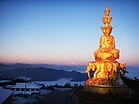

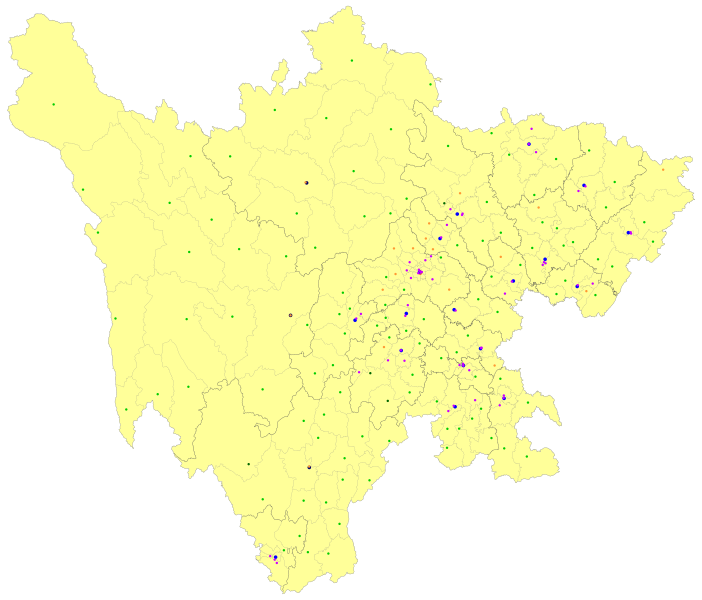

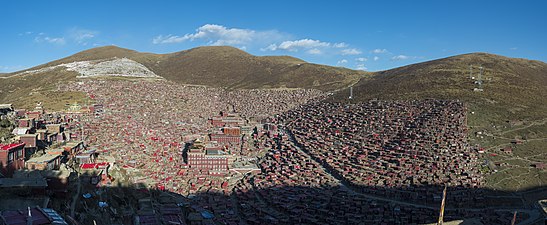

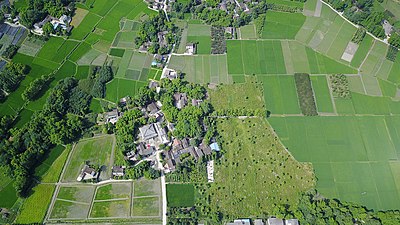




![Baba Mosque [zh], a Chinese Sufi mosque in Langzhong.](https://upload.wikimedia.org/wikipedia/commons/thumb/1/1f/%E5%B7%B4%E5%B7%B4%E5%AF%BA.JPG/120px-%E5%B7%B4%E5%B7%B4%E5%AF%BA.JPG)




